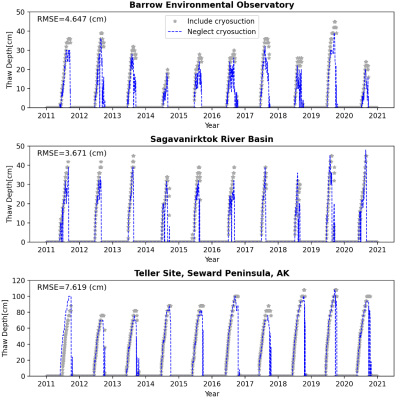Quantifying the Importance of Cryosuction in Permafrost-Rich Soils
All models must make assumptions about which physical processes are important and which are not. Here we challenged three assumptions commonly used in models of permafrost-rich soils by comparing simulations with and without these assumptions at three sites in Alaska. Critically, cryosuction – the process by which liquid water is sucked into a freezing soil – was found to be an important process to accurately predict the movement of water, the thaw depth, and other hydrologic variables.
Permafrost-rich soils in the Arctic store a huge quantity of frozen carbon, and the fate of this carbon is uncertain in a warming climate. This study provides key understanding of how permafrost-rich soils behave while they freeze and thaw annually.
This study looked to evaluate the roles of advective heat transport, the expansion of water as it freezes to ice inside soils and cryosuction. Most permafrost models ignore all three of these processes, but the Advanced Terrestrial Simulator (ATS), BER’s code for permafrost hydrology at field scales, allows each of these three processes to be turned on and off. Simulations were run with and without these processes, and multiple metrics, including streamflow, thaw depth, evaporation, and other hydro-thermal fluxes, were compared. This was done at three different field sites, each with different weather, soil properties, and land cover, to build confidence in the robust validity of ignoring these processes. Including advective heat transport or the expansion of water as it freezes to ice were found to change predictions minimally. Including cryosuction, however, was found to significantly affect thaw depth and the distribution of water throughout the soil, and therefore have significantly changed evaporation and streamflow. Ignoring cryosuction resulted in the systematic underprediction of thaw depth by 10-30%, with corresponding errors in thawed carbon.

